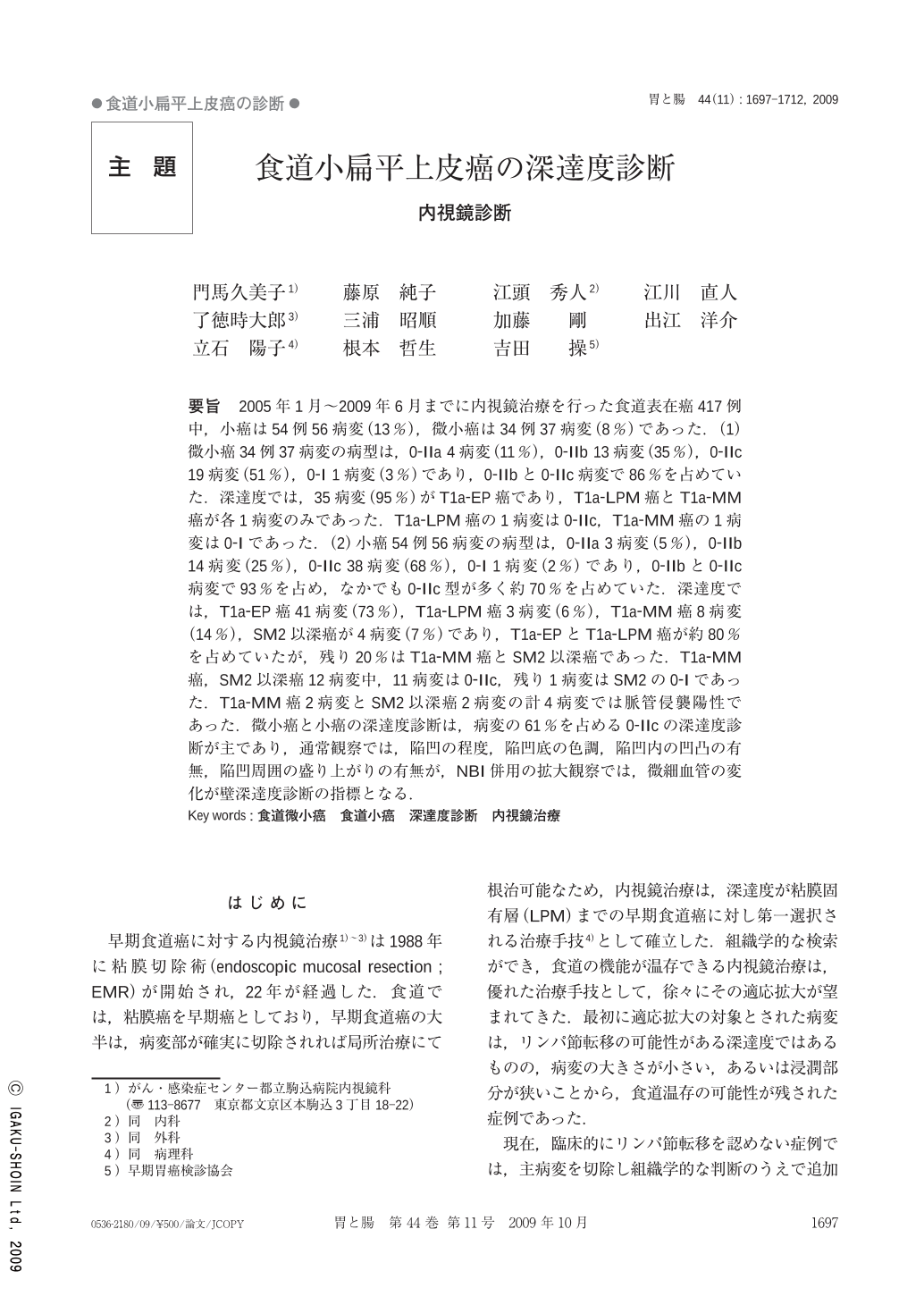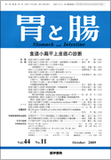Japanese
English
- 有料閲覧
- Abstract 文献概要
- 1ページ目 Look Inside
- 参考文献 Reference
- サイト内被引用 Cited by
要旨 2005年1月~2009年6月までに内視鏡治療を行った食道表在癌417例中,小癌は54例56病変(13%),微小癌は34例37病変(8%)であった.(1)微小癌34例37病変の病型は,0-IIa 4病変(11%),0-IIb 13病変(35%),0-IIc 19病変(51%),0-I 1病変(3%)であり,0-IIbと0-IIc病変で86%を占めていた.深達度では,35病変(95%)がT1a-EP癌であり,T1a-LPM癌とT1a-MM癌が各1病変のみであった.T1a-LPM癌の1病変は0-IIc,T1a-MM癌の1病変は0-Iであった.(2)小癌54例56病変の病型は,0-IIa 3病変(5%),0-IIb 14病変(25%),0-IIc 38病変(68%),0-I 1病変(2%)であり,0-IIbと0-IIc病変で93%を占め,なかでも0-IIc型が多く約70%を占めていた.深達度では,T1a-EP癌41病変(73%),T1a-LPM癌3病変(6%),T1a-MM癌8病変(14%),SM2以深癌が4病変(7%)であり,T1a-EPとT1a-LPM癌が約80%を占めていたが,残り20%はT1a-MM癌とSM2以深癌であった.T1a-MM癌,SM2以深癌12病変中,11病変は0-IIc,残り1病変はSM2の0-Iであった.T1a-MM癌2病変とSM2以深癌2病変の計4病変では脈管侵襲陽性であった.微小癌と小癌の深達度診断は,病変の61%を占める0-IIcの深達度診断が主であり,通常観察では,陥凹の程度,陥凹底の色調,陥凹内の凹凸の有無,陥凹周囲の盛り上がりの有無が,NBI併用の拡大観察では,微細血管の変化が壁深達度診断の指標となる.
In order to find clinical and pathological features of small squamous cell carcinomas of the esophagus,88 cases with 93 small cancer lesions were analyzed in this study. They occupied 18.2% of 417 cases with superficial and squamous cell carcinoma of the esophagus that underwent endoscopic resection from January 2005 to June 2009.
Results:(1)54 cases(13% of all cases)had 56 small cancer lesions less than 10mm in size and 34 cases(8%)had 37 minute cancer lesion less than 5mm.(2)In cases with minute cancers(37), 4 lesions(11%)could be classified into type 0-IIa, 13 lesions(35%)type 0-IIb, 19 lesions(51%)type 0-IIc and 1 lesion(3%)type 0-I. Type 0-IIb and type 0-IIc lesions occupied 86% of all minute squamous cell carcinoma lesions. Pathological studies on resected specimens revealed that 35 lesions(95% of all minute cancer lesions)remained in the epithelium(EP), one lesion(2.5%)infiltrated into the lamina propria mucosae(LPM)and also another one lesion(2.5%)reached to the muscularis mucosae(MM). One minute LPM cancer was a type 0-IIc lesion and another MM lesion was type 0-I.(3)In cases with small cancers(56), 3 lesions(5% of all lesions)were type 0-IIa, 14(25%)0-IIb, 38 lesions(68%)type 0-IIc and one(2%)type 0-I. Type 0-IIb and 0-IIc lesions occupied 93% of all minute cancer lesions. Fourty one lesions(73% of all small cancer lesions)were EP cancers, 3 lesions(6%)LPM, 8(14%)MM and 4(7%)invaded moderately into the submucosa(SM2). EP and LPM cancer lesions occupied 80% of all small cancers while residual 20% included lesions with deeper invasion into MM and SM2. All eight lesions with MM invasion were type 0-IIc cancers, three of four SM2 cancers were also type 0-IIc and one lesion was type 0-I lesion. Microvascular permeation was noted in 2 among 8 MM cancers(25%)and 2 among 4 SM2 cancers(50%), suggesting probable lymph node metastasis.(4)EP and LPM cancers occupied 86% of all small and minute cancers and MM and SM 14%. Endoscopic differentiation of type 0-IIc lesions with deeper invasion is most important in endoscopy, for type 0-IIc occupied 85% of all small and minute cancers with MM or SM invasion. Partial and deeper depression, partial and dark reddening, granular irregularities in the depressed area and marginal elevation of type 0-IIc lesions strongly suggested deeper invasion at conventional endoscopy. Abnormalities in IPCL by NBI observation are suggestive of deeper invasion.
Conclusions:(1)Type 0-IIb and 0-IIc lesions occupied 90%(IIb : 29% and IIc : 61%)of all small and minute cancers. (2)EP and LPM cancers occupied 86% of all small and minute cancers. (3)Differentiation of type 0-IIc cancers with MM and SM invasion is point of endoscopic diagnosis on small and minute squamous cell carcinoma of the esophagus, for type 0-IIc lesions occupied 85% of all MM and SM cancers.

Copyright © 2009, Igaku-Shoin Ltd. All rights reserved.


